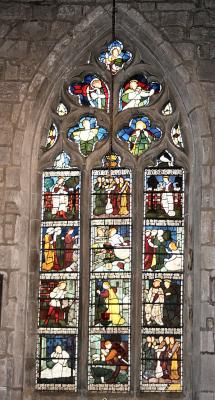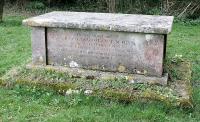
Nat Gould
His life and books
Raphael Gillum 1769-1860
| Raphael Gillum |
|---|
| Born: 1769 at Hackney, London |
| Died: 1860 at Clifton, Bristol |
| Father |
| William Gillum died 1769 |
| Mother |
| Mary Gillum died 1819 |
| Siblings |
| William Gillum died 1797 |
| Thomas Gillum died 1802 |
| Spouse |
| Mary Gould 1780-1850 m 25 April 1816 |
Raphael Gillum was baptised on 1 October 1769 at St John’s church in Hackney, London. His parents were William Gillum and his wife Mary Gillum. He had two older brothers, William Gillum and Thomas Gillum
He married Mary Gould, daughter of William Gould 1748-1795 and his wife nee Mary Saunders 1750-1829 on 25 April 1816.
Raphael Gillum qualified as a doctor in Edinburgh in 1794, his graduation thesis being entitled “Disputatio medica inauguralis, de febre puerperarum” (Inaugural medical dissertation on puerperal fever)(1). Many women died after childbirth from the infection called puerperal fever before Joseph Lister introduced aseptic surgery.
By 1802 Dr Gillum was a “ Physician of the city of Bath”, when he witnessed a will. He was then interested in vaccination, following the discovery by Edward Jenner and others that inoculation with cowpox provided immunity against the dreaded smallpox. Gillum took these idea of vaccination further, arguing in 1806 that inoculation with smallpox itself (variolation) gave immunity against plague. His theory was that “diseases of a very opposite kind or state seldom, perhaps never, prevail together”, and that if inoculation with cowpox replaced variolation then plague would return.
The Edinburgh Review mocked him. “This sagacious conjecture is assumed as a fact in another lucubration of the same author ‘On the Efficacy of inoculated Smallpox in promoting the Population of Great Britain’ ” (2). Raphael Gillum had written this article for the Edinburgh Medical and Surgical Journal from Bath in October 1810, concluding that “It is the duty every member of society owes to his country and posterity to promote the inoculation of small-pox, decidedly opposing any attempt to deprive mankind of this invaluable GIFT OF PROVIDENCE.” The Edinburgh Review derided Raphael Gillum as a “profound and patriotic writer” in arguing that variolation would have “saved to the country the multitude of inhabitants formerly destroyed by the plague”.

The Gillum Window at Darley Dale Church
Even the editors of The Edinburgh Medical and Surgical Journal felt obliged to add a note after the article: “Though we have given place to this singular speculation of Dr Gillum, we are very far from adopting his sentiments, or participating his fears”.
The Edinburgh Review went further, “leaving Dr Gillum to his profound meditations, it is time for us to enter upon the cardinal point of the controversy, which is, whether vaccination be an effectual preventative of smallpox or not. (3)” That was to be finally settled when inoculating with smallpox was banned in 1840.
Raphael Gillum was listed as resident at 39 River Street in Bath in an 1839 Directory. In the 1841 Census Return he was recorded as a physician living in River Street in Bath, together with his wife aged 50 and two female servants.
Mary Gillum died on 28 August 1850 at the Green, Lea near Matlock in Derbyshire (4).
She was buried at Darley Dale in Derbyshire.
Her husband was still at 39 River Street in Bath, as recorded in an 1851 Directory. In the Census Return for that year, however, he was visiting Joseph Wass, a lead merchant at Lea Green Villa, Lea in Derbyshire.
Dr Raphael Gillum died aged 90 on 4 January 1860 at 32 Royal York Crescent in Clifton near Bristol.
He was buried with his wife in the churchyard at Darley Dale, and there is a memorial stained-glass window to him in the south transept of the church.
This window, of twelve panels depicting scenes from the Song of Songs in the Old Testament, designed in 1862 by Edward Burne-Jones (5), was ordered by his great-nephew William James Gillum. Raphael and Mary Gillum had no children, and he was the chief beneficiary in Dr Gillum’s will.
William James Gillum, born in Winchester in 1827, took up a military career. During the Crimean War he lost a leg and returned to England in 1855. By the 1860s he had become not only a patron of the arts, but also a philanthropist and benefactor of the poor in London. In 1860 he bought Church Farm at Barnet in Hertfordshire for use as a school for poor London boys of good character, where they were educated and taught a trade. Some of their furniture went to the firm of William Morris. He also persuaded the architect Philip Webb to design a row of workshops with accommodation above in Hackney, not far from the London church where Raphael Gillum had been baptised (6).
(1) The Edinburgh Magazine, or Literary Miscellany, July 1794 page 77.
(2) Edinburgh Medical and Surgical Journal 1806.
(3) The Edinburgh Review; or Critical Journal volume 15 (1810).
(4) Derby Mercury 11 September 1850.
(5) In 1862 Edward Burne-Jones (1833-1898) produced twelve designs for the window, eight of which are now in Birmingham Art Gallery. He was one of the Pre-Raphaelite Brotherhood of artists, of which Colonel William James Gillum was a friend and patron.
(6) Studies in Art, Architecture, and Design : Victorian and after N. Pevsner (1908) page 121.


